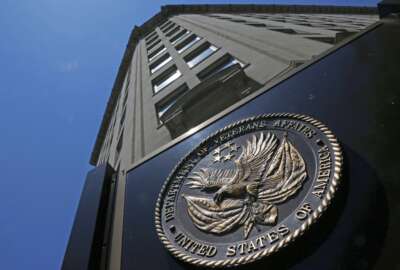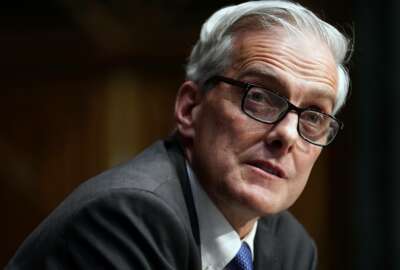

The Department of Veterans Affairs is embarking on a year-end push to implement all the workforce provisions of the recently passed PACT Act as the agency prepares...
Best listening experience is on Chrome, Firefox or Safari. Subscribe to Federal Drive’s daily audio interviews on Apple Podcasts or PodcastOne.
The Department of Veterans Affairs is embarking on a year-end push to implement all the workforce provisions of the recently passed PACT Act as the agency prepares for a historic expansion of VA benefits and care.
The agency is looking to bring on more health care workers in anticipation of a major expansion of VA health care under the PACT Act. The VA begins to adjudicate those health care and benefits claims at the start of the New Year.
Undersecretary for Health Shereef Elnahal told the Senate VA Committee on Nov. 17 that the agency expects to complete all PACT Act policy changes around hiring by the end of the calendar year.
“Hiring faster and more competitively by consistently implementing these new authorities everywhere is my top priority,” Elnahal told the committee.
Committee Chairman Jon Tester (D-Mont.) said the PACT Act allows more veterans to get health care and benefits that they have earned, but requires VHA and VBA to ramp up hiring to accept new patients and claimants,.
“Look, we all know they’re going to be hiccups. Veterans who previously filed claims will now hear of many more of their brothers and sisters joining them in line. But the VA must ensure that each of them gets the right decision as quickly as possible,” Tester said.
VA so far has implemented four sections of Title 9, the part of the PACT Act focused on recruiting and retention incentives.
Chief Human Capital Officer Tracey Therit told the committee that VA is focused on implementing the workforce provisions of the PACT Act through several waves.
Under the first wave, the VA lifted restrictions on how many housekeeping aides it would hire. Therit said the VA hired more than 700 housekeeping aides in the past 90 days and increased its onboarding rate for these positions by more than 3%.
Elnahal said the VHA also made a “historic investment” in hiring 3,600 health care enrollment specialists since Oct. 25 and trained them to understand which veterans qualify for benefits under the PACT Act.
Therit said the VA in its second wave is building out its next generation of the workforce by reaching out to new college graduates and implementing elements of the PACT Act that increases student loan repayment.
The VA is also removing some of the restrictions on awards and bonuses, and setting higher limits on special contribution awards, in order to retain top-performing employees.
Therit said the VA is prioritizing increased pay and bonus authority to ensure pay remains competitive for VHA and VBA personnel, as well as for its Office of Information Technology employees.
“We have a lot of critical pay authorities, special salary rate authorities, incentives, and waivers of pay authorities to make sure that we have no barriers and limitations to getting who we need on board to serve veterans,” Therit said.
Therit said the VA is improving IT systems that support hiring and onboarding.
“We have made some enhancements which give greater visibility where things are in the hiring process so that we can move them long quickly,” she said.
Committee Ranking Member Jerry Moran (R-Kan.), however, raised concerns that the VA, especially in rural areas, isn’t able to set higher pay fast enough to keep up with market demand for health care workers.
Moran said Kansas VA facility staff say private-sector health care workers can set higher pay much more quickly can what the agency can do.
“Even though they have the authority to increase clinicians’ pay when the market pay increases, they say that by the time VHA human resources completes all the necessary views and sign-offs, the private sector has already begun another pay increase before the VA can match the first. They are always at least one pay increase behind what they should be,” Moran said.
While the PACT Act gives the VA plenty to implement, the agency’s fiscal 2023 budget request calls for additional pay incentives, such as raising the $400,000 salary cap for physicians.
Elnahal said the agency is also looking to raise pay caps on VA dentists and podiatrists.
“In order to recruit the right folks on the physician, dentist and podiatrist side, it’s becoming much more difficult, especially in rural areas, as salaries go up and the health care labor market becomes more difficult,” Elnahal said. “And we will be able to pay more innovatively as well to incent the right behavior among these clinicians, if we’re able to get that.”
Elnahal said the VHA is also on track to complete a national rural recruitment and hiring plan for healthcare professionals by early 2024.
“These are more difficult healthcare labor markets, it’s harder to get folks recruited for these critical positions. We are actually approaching this in, I think, an innovative way. We’re taking our experts in workforce management and human resources and combining them with our implementation science researchers to collate the data that is available to understand what a targeted outreach plan could look like and make that an actually an evidence-based effort,” he said.
The VBA is also staffing up to handle thousands of additional benefits claims.
Acting Undersecretary for Benefits Josh Jacobs said VBA has been preparing for PACT Act since last year, and hired 2,000 additional employees in anticipation of the legislation. Jacobs said the VBA anticipates adding another 1,900 employees in the coming months.
Jacobs said all VBA employees are going through training to properly process PACT Act claims
“This training is crucial to ensure that all new PACT Act claims are processed correctly and quickly,” Jacobs said.
Jacobs said the VA so far has received about 146,000 PACT Act claims, but expects to receive upwards of 700,000 claims by the end of the fiscal year.
“As we continue to encourage more veterans and survivors to apply for their PACT Act benefits, we do expect an increase to the inventory and the backlog in the short term,” Jacobs said.
VBA is using automation as a decision-support tool to expedite claims, following a successful automation pilot in January.
Jacobs said VBA processed 1.7 million veteran claims 12% more than the previous year. The claims backlog, he added, is now down to 150,000 claims, the lowest point in years. “I’m happy to say that today we’re in a better position to tackle this increased workload,” Jacobs said.
Moran, however, raised concerns about VBA having enough bandwidth to handle a surge in claims.
“Veterans must not be left waiting in longer lines for benefits or care,” Moran said.
Copyright © 2025 Federal News Network. All rights reserved. This website is not intended for users located within the European Economic Area.
Jory Heckman is a reporter at Federal News Network covering U.S. Postal Service, IRS, big data and technology issues.
Follow @jheckmanWFED


